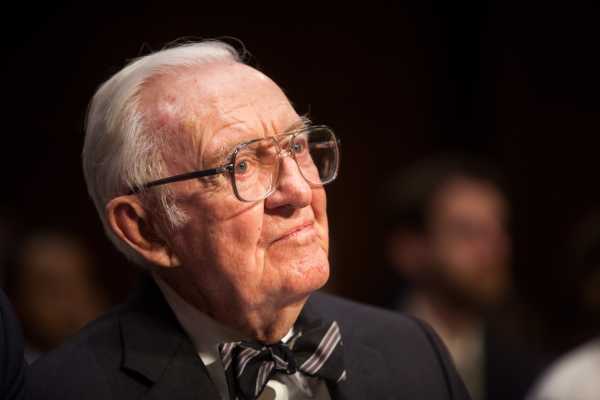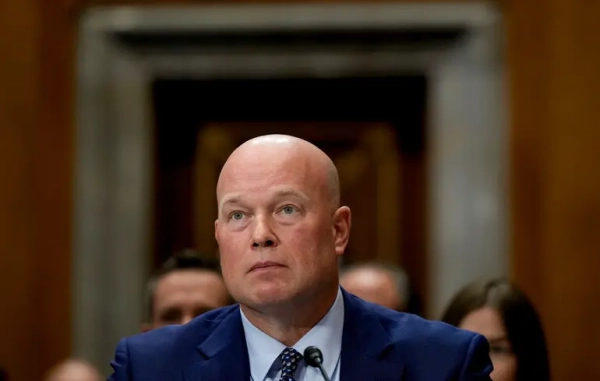
Former Supreme Court Justice John Paul Stevens, who died at the age of 99 on Tuesday, was a Republican appointed by President Gerald Ford. But Stevens took a position that would make even many liberals blush: He called for repealing the Second Amendment.
Stevens made the argument for repeal in a New York Times op-ed last year, in response to the March for Our Lives movement that came out of the Parkland, Florida, school shooting. He argued that for most of US history, the Second Amendment was interpreted narrowly — not placing a strict limit on federal or state governments’ ability to regulate firearms. But that changed recently, when the Supreme Court ruled that the Second Amendment protects an individual right to bear arms, Stevens wrote:
Although Stevens viewed this as a misinterpretation of the Second Amendment, the reality is it’s now enshrined into constitutional law. So reformers should take drastic action, Stevens wrote, to “eliminate the only legal rule that protects sellers of firearms in the United States — unlike every other market in the world. It would make our schoolchildren safer than they have been since 2008 and honor the memories of the many, indeed far too many, victims of recent gun violence.”
I’ve argued that repealing, or at least reinterpreting, the Second Amendment should be part of a bolder progressive agenda on guns, one that enables policies that reduce the number of firearms in the US. Right now lawmakers are tied by the Second Amendment in how far they can go, even as the research shows the US leads the developed world in gun violence largely because it has so many guns — more than any other country in the world — and maintains lax means, legally or otherwise, to obtaining those weapons.
Still, the barrier to passing new gun laws isn’t legal but political. At this point in US politics, lawmakers aren’t so much worried about their proposals getting struck down by a court as they are about the political backlash to new gun laws. And if Congress and many states can’t pass even milder gun control measures on these political grounds, they’re not going to strike down a constitutional amendment. Something will have to give in the politics first.
The Second Amendment really has been reintrepreted
Stevens’s history isn’t wrong here — the Second Amendment really has been reinterpreted over time.
For much of US history, the Second Amendment was seen as defending collective, not individual, rights. This protected the right to bear arms only within the context of a militia. It’s only more recently that the Second Amendment has been expanded to protect an individual right to bear arms, making it much more difficult to regulate guns.
The collective approach, Fordham University historian Saul Cornell previously told me, came out of a Cincinnatus view toward guns and defense — a reference to the legendary Roman general who, according to the story (and possibly myth), went back to farming instead of attempting to seize more power after he led the Romans to victories.
This kind of republican value was embedded in the US at the time of its founding, so the founders made sure to enshrine it in the Constitution. But it only preserved the collective right to own firearms insofar as able-bodied men needed the weapons to help defend their state and country.
Courts and legal scholars widely accepted this for decades.
Consider previous Supreme Court decisions: In 1939, the Court unanimously ruled in United States v. Miller that Congress can ban sawed-off shotguns because that weapon was of no use in a well-regulated militia, making it clear that the right to bear arms was inseparable from the role of a militia.
Justice James McReynolds wrote in the majority opinion, “The Court cannot take judicial notice that a shotgun having a barrel less than 18 inches long has today any reasonable relation to the preservation or efficiency of a well-regulated militia, and therefore cannot say that the Second Amendment guarantees to the citizen the right to keep and bear such a weapon.”
That only changed in 2008’s District of Columbia v. Heller, when the Court concluded that “the Second Amendment conferred an individual right to keep and bear arms.”
This was in part a result of decades of campaigning by gun rights activists, particularly the National Rifle Association (NRA), to change how the public views the Second Amendment.
As Carl T. Bogus, a researcher at the Roger Williams University School of Law, noted in a 2000 law review article, before 1970, “a total of three [law review journal] articles endorsed the individual right model and twenty-two subscribed to the collective right view.” He added, “From 1970 to 1989, twenty-five articles adhering to the collective right view were published (nothing unusual there), but so were twenty-seven articles endorsing the individual right model.”
At least 16 of the individual rights model articles “were written by lawyers who had been directly employed by or represented the NRA or other gun rights organizations, although they did not always so identify themselves in the author’s footnote.”
By the 1990s, the tide had changed: “At least fifty-eight law review articles endorsing the individual right view would be published during the 1990s (compared to twenty-nine favoring the collective right position).”
It can be easy to underestimate the impact of these kinds of journal articles. Many people may wonder who even reads law review journals. The answer is legal scholars, lawyers, judges, and politicians — and these people then permeate their ideas in popular media and in their day-to-day work. Over time, that can lead to a big shift in public opinion and policy.
The Supreme Court’s new reading of the Second Amendment reflects that. And from Stevens’s view, it created such an untenable position that he argued the amendment must be repealed.
The biggest barriers to gun control are political, not legal
While Stevens’s historical retelling was correct, the reality is his proposal isn’t going to get very far. But there’s a case to be made for his call for repeal anyway — because it’s the kind of perspective that may help shift the Overton window on guns.
Adam Winkler, a UCLA law professor and author of Gunfight, previously argued on Twitter that the primary hurdle with guns is a political battle rather than a legal one: Even before the Supreme Court’s Heller decision, gun control struggled — because organizations like the NRA made it very difficult, politically, to get anything done. That’s the real hurdle, Winkler claimed, more than how the courts interpret the Second Amendment.
The political obstacle has not been public opinion per se. Based on surveys by Gallup and the Pew Research Center, a majority of Americans back stricter gun laws, and even bigger majorities support specific policies like universal background checks, restrictions on people with mental illness buying guns, an assault weapons ban, and a federal database to track gun sales, with support for these policies sometimes topping 75 percent even among Republicans. This has been true for years in US politics.
Instead, the big obstacle is issue intensity. Republican strategist Grover Norquist put it this way, back in 2000: “The question is intensity versus preference. You can always get a certain percentage to say they are in favor of some gun controls. But are they going to vote on their ‘control’ position?” Probably not, he suggested, “but for that 4-5 percent who care about guns, they will vote on this.”
The March for Our Lives, and many demonstrations and actions that followed, may have started to change this. By getting people riled up over the issue of guns — to the point that hundreds of thousands marched in Washington, DC, and supporters of stricter gun laws won midterm elections last year — the movement seems to have developed a voting group that’s just as passionate on gun control as the other side is for gun rights.
At the same time, much of the evidence suggests that the US will at some point need to go further on guns than much of the current discussion suggests. The research indicates that the core problem in the US is it simply has too many firearms. The current policy proposals don’t do much to address this core problem.
It’s straightforward: Everywhere in the world, people get into arguments. Every country has residents who are dangerous to themselves or others because of mental illness. Every country has bigots and extremists. But here, it’s uniquely easy for a person to obtain a gun, letting otherwise tense but nonlethal conflicts escalate into deadly violence.
Universal background checks wouldn’t address this. Even an assault weapons ban wouldn’t, because the great majority of shootings — 70-plus percent of gun homicides, for instance — involve a handgun. That’s why I’ve argued for tighter restrictions on all guns, including up to all semiautomatic weapons or at least some types of handguns, and a buyback program that would confiscate these guns out of circulation (much like Australia did).
Much of that is not politically realistic today. But just as Democrats have over the years shifted debates over health care, climate change, college, and taxes on the ultrawealthy, they could get a similar discussion rolling on guns too. Perhaps Stevens’s call to repeal the Second Amendment is one way to get that conversation going, demonstrating that this is a view at least some respectable, mainstream legal scholars hold.
If nothing else, it could help balance the scales. The NRA has successfully worked against policies, like universal background checks, that are enormously popular with the US public. Perhaps an equal counterweight on the other side could, overall, push the country closer to the middle ground that most Americans already support.
Sourse: vox.com






